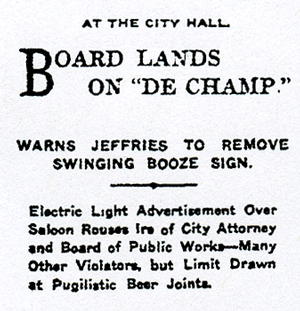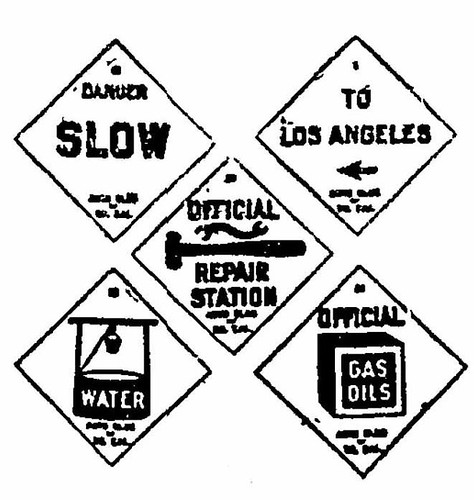November 5, 1907
Los Angeles
Just as an innocent toke of reefer leads to a lifetime of laudanum addiction, everybody knows that electric signs lead to…neon!
Neon wouldn’t be introduced to the United States until 1923 (specifically, at the Earl C. Anthony Packard dealership, 10th & Hope Street). That first reefer toke, though…that was the electric sign…
Property owners of 1907 argue that electric signs, particularly those of the swinging variety which jut from the façades of buildings, make the streets look tawdry. Moreover, they nullify the illumination systems on principal business streets, and will become eyesores and nuisances.
The Mayor, however, is outspoken in favor of electric signs. They illuminate business thoroughfares, and are an ornament to the city. A man of vision, our Mayor Harper.
But what to do, then, with the Jim “de champ” Jeffries’ new saloon sign on South Spring? He has had one built and installed, swung over the sidewalk, “bearing in letters as big as one of his mitts the magic pugilistic name.”
While this type of signage violates numerous and sundry City ordinances, the Board of Public Works has ignored similar signs in the downtown area that advertise cafés and theaters, who are crying foul in that municipal authorities have allowed such signs to hang for the last year. Because of Jeffries’ transgression, he and all other sign owners received letters from the City Attorney demanding the removal of any and all projecting signage, the worry being that should these signs become commonplace, “the sidewalks would be converted into tunnels darkened and obstructed by a covering of advertising signs.”
Moreover, a proposed ordinance shall prohibit signage advertising liquor. Can this be?
Mayor Harper stands firm. What will become of our city?
 Here’s a vision of the future: electric signage along Broadway, ca. 1920, as pictured in, uh, this book.
Here’s a vision of the future: electric signage along Broadway, ca. 1920, as pictured in, uh, this book.



